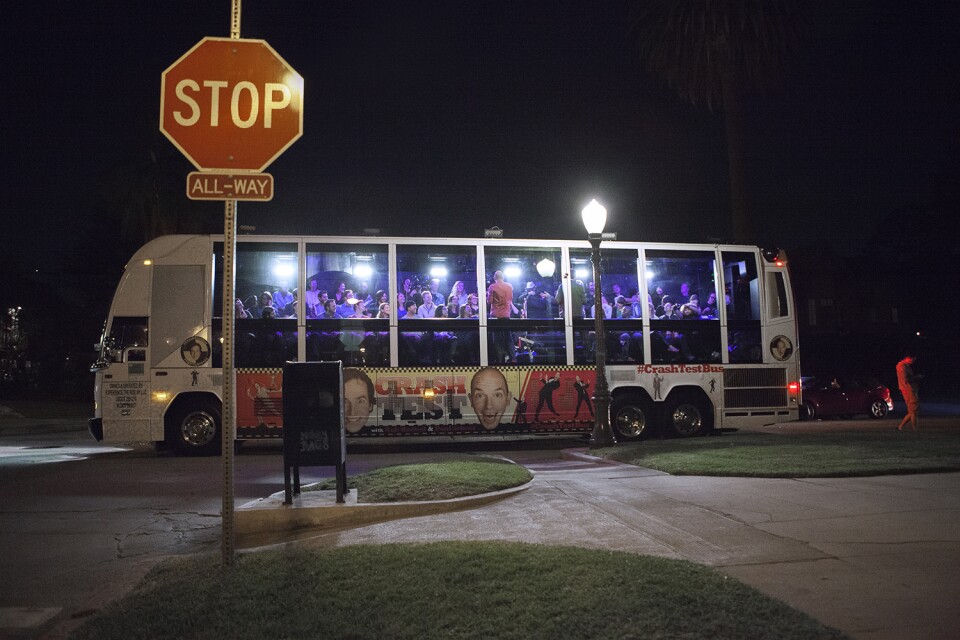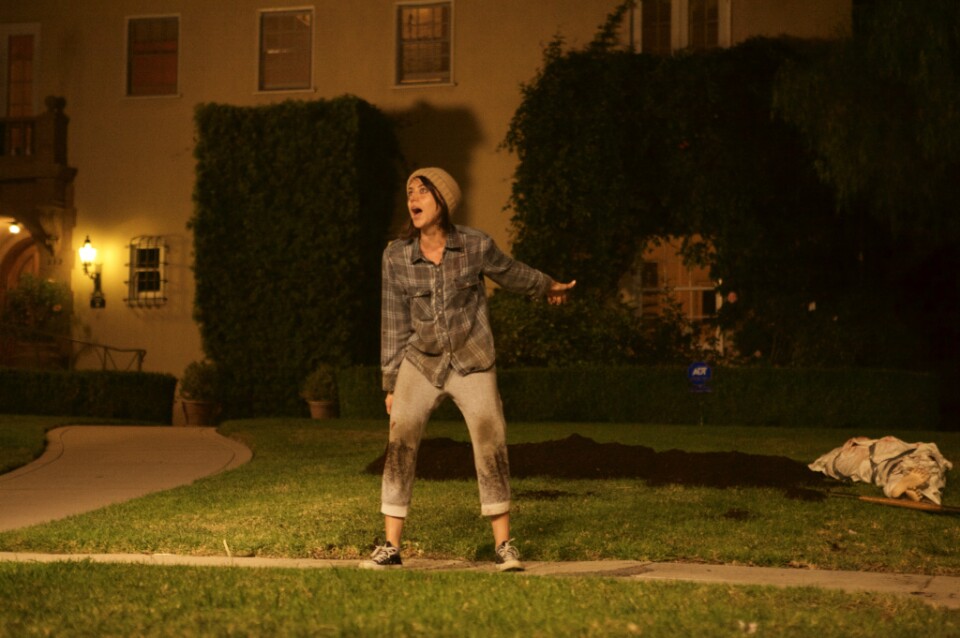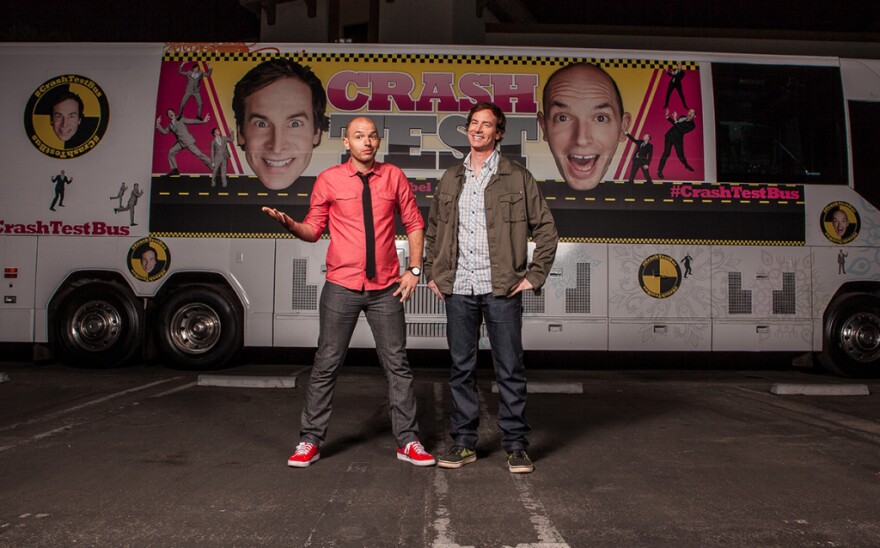Comedian collaborators Paul Scheer and Rob Huebel talk about moving their stand-up comedy show into a bus and out onto the streets of L.A.; We talk to artist Martine Syms about her short film "Laughing Gas" on display at "Made In L.A." at the Hammer Museum; Streaming services like Netflix, Hulu and Amazon don’t usually play the audience numbers game. But now Nielsen has independently assembled ratings for three streaming shows: “Orange is the New Black," “Better Call Saul" and “Seinfeld."
Nielsen releases audience data for Netflix, Hulu shows for the first time
Netflix and most other streaming services like Amazon and Hulu have historically kept their audience numbers secret.
But just recently Nielsen, a company that studies consumer behavior, was able to gather viewership figures for a few streaming TV shows.
At a conference in Las Vegas, Nielsen shared data on “Orange is the New Black” and “Better Call Saul” on Netflix and “Seinfeld” on Hulu. Lots of industry people dispute Nielsen's accuracy, but networks nevertheless use the information not only to set ad rates, but also to decide which shows are renewed and canceled.
For details on Nielsen's new data we called Amol Sharma, the Media and Marketing Bureau Chief at The Wall Street Journal, who broke the story.
Paul Scheer and Rob Huebel take their UCB comedy show 'Crash Test' onto the streets — and into a bus
What happens when two comedians take their popular stand-up show (and its audience) into a tour bus?
The Comedy Central special “Crash Test" with Rob Huebel and Paul Scheer is a mobile version of their variety stand-up show, which they host at the Upright Citizens Brigade theater in Los Angeles.
The entire show takes place out on the streets of LA, in and outside a huge, glass-walled tour bus. Scheer and Huebel drive their audience throughout the city to locations where other comedians are performing bits. For instance, they meet Aziz Ansari at a taco joint, encounter Natasha Leggero walking her dog and catch Aubrey Plaza burying a body in someone’s front yard.
But "Crash Test" is just one of the ways in which longtime friends Scheer and Huebel collaborate. They also produced “The Interrogation,” which they call the first virtual reality comedy sketch. Produced by Funny or Die, "The Interrogation" screened at the Sundance Film Festival earlier this year.
When the two joined The Frame in studio, they began by discussing the origin of their "Crash Test" show.
Interview Highlights
What was the idea behind "Crash Test." How did you guys first get started?
Scheer: We started the show with Aziz Ansari who was part of this sketch group that Rob and I were in called Human Giant. When we originally started it, it was a chance for us to mess around and do what we wanted.
Huebel: Yeah, it's a stand-up show and so we always know there's going to be three or four stand-ups who are going to do really tight written material. So we come on as hosts and do looser, improvised stuff. So that's sort of the live show and then out of that came this other thing -- this TV thing that we shot.
Scheer: The one thing about the show that has always been really fun for me is, Rob and I performed at the Upright Citizens Brigade for forever.
Is that where you guys met?
Scheer: Yeah, we met there. The best part about it is, it's a small audience so you feel really connected to them. What "Crash Test" has done is, they come week after week, primarily to see us, even though we're not doing the stand-up because we're the anchor of the show so we let them become a part of the show whether we're going into the crowd talking to them, taking them on stage and making them do a talent that may not have thought they were going to perform before they got there. We always joked, because the show is so late, wouldn't it be fun if, instead of doing the show at the theater, we did it on a bus and we just went to comedians houses and had them perform for us there?
Kind of like a progressive dinner?
Huebel: It just seemed easier. Also, comedians are lazy and sometimes it's hard. Our show is at 11:00 at night so we always thought, yeah it'd be easier if we just drove to them.

At the live show would you start recognizing faces? Was it like a family affair?
Huebel: every week, we make people raise their hands if they've never been there before. There's always like 10 people who raise their hands and they get booed by the regulars.
Scheer: Then we tell them, when they come back the next week, they can boo the people that are new there. So it become like a little bit of a cult.
Huebel: It's a little cult. We're starting a cult.
Scheer: We just start to communicate with the audience. The show becomes a lot of the times us talking to them and doing weird things with them. At one point, we did a Sader with the audience. Rob and I never did a Sader before so we were like, let's see what that's like. So we went to this grocery store next door, we bought the supplies, and had someone from the audience who was familiar with running a Sader, run a Sader for us.
Was it a comedic Sader or was it a serious Sader?
Huebel: It was pretty serious.
Scheer: Yeah. We always do anything religious very seriously.
Huebel: The show is very religious.
So when you have this idea of taking this in theater experience out on the road, probably the first order of business is what is the vehicle going to look like. You have a very special bus which has an entire glass side? How would you describe it?
Scheer: This is the funny thing. We were talking about this bus idea for a long time and I remembered one day I was like, oh my god when I was in New York last time, I saw this bus traveling around 42nd street -- that should be our bus!
You mean like a tour bus?
Huebel: It's this big -- there's only like a couple of them -- it's this big thing called "The Ride." It's a giant glass bus and it has movie theater seats in it.
That face outward?
Huebel: That face outward, yeah. So everyone is driving around facing the sidewalk and then there are microphones in the bus that project out to the street, so if you're in the bus, you can talk to people on the sidewalk, you can yell at cars going by. All of that proved very useful to us because when we had this company drive it all the way from New York...
So it is that bus?
Huebel: It is that bus.
Scheer: That was the only bus that made sense because it made the street the stage. Because of the budget and the timing of it, we had one day -- we basically decked it out with cameras, lights.
Huebel: We rigged it up and yeah we just had one night. We called all of our comedy friends and just said, be at this address at 8:15.
And let's pray we don't hit traffic.
Huebel: Yeah, exactly.
Scheer: And there's no way to rehearse for that type of show. We could plan out as much as we wanted. We had bits, we had ideas, we had locations to hit, but we knew that the night was going to take its toll if we got caught in traffic or if we bump into somebody interesting in front of Mann's Chinese Theater. Basically we took an 8-hour show and edited it down to an hour-long show.

Is there a separate van following the bus that's filled with lawyers getting releases from everybody on the sidewalk?
Huebel: Yeah, you know how television works. It's pretty close. We had a production crew chasing down people to get releases, which was a huge hassle.
Scheer: We basically had a little military operation because we're a moving bus driving through LA on a Sunday night trying to grab whoever we could grab. We at one point passed a valet and this guy was paying the valet and we started chanting, tip him more! Tip him more! Tip him more! And this guy just awkwardly went back into his pocket and pulled out more money and the whole bus started cheering. It was great. So we had those moments where we could run and get those people so we could air that.
How would you describe this show? It is a show for a live audience in the bus that is unlike watching live comedy but it's also a television thing -- you have camera's that are watching audiences react.
Huebel: It's a mobile comedy variety show where everyone dies at the end.
Scheer: Everyone always dies. Um, I'm obsessed with the idea of what's the next type of variety show. When you hear about variety show, people are always like, oh I'm going to play a piano and we're going to sing songs and dance and it's all cutesy 50s stuff. It's like, how can we do the now version of that because that was topical and current in the 50s and 60s when that was going on with The Sonny & Cher Variety Hour. How can we make that current and feel like what that was when people saw it then.

So in addition to virtual reality porn, there is virtual reality comedy. Can you talk about "The Interrogation?"
Huebel: Yeah, Paul and I wrote and shot a virtual reality sketch. I think it was one of the first virtual reality sketches right?
Scheer: I think it was the first comedy virtual reality.
Huebel: Yeah there isn't a lot of comedy right now in the virtual reality space and so our friends at Funny or Die came to us with an idea of a sketch and it's basically just a fart joke. It's a good cop, bad cop interrogation. So the viewer, when you're watching this in virtual reality, you are getting screamed at by these two maniac cops in an interrogation room. It's really bizarre though because you're experiencing it in total solitude. It's not like going to a movie where everyone is ... it's not a shared experience. It's really bizarre.
Scheer: And you can look at the audience and everyone is facing forward for most of the part, but then you see people just drift off. You can look in 360 degrees so people are looking up and down. So that's the interesting thing too. You can lose them very quickly.

Before we started talking, we were chatting about this apparent renaissance of close-up magic and that there are these great magicians that are working in LA. Do you feel the same is happening with comedy? Is it a good time to be a comedian? Is it always hard to figure out where you're going to make a buck and where your next gig is or does it feel like the idea of VR, internet short-form videos is actually really transforming the way in which you guys can work?
Huebel: That's a great question. I think it is a great time to be a comedian and I think that it's a great time to be in the entertainment world, because as we said, things are shifting and changing so much with ... there are so many different platforms. You know it used to be you could only do a TV show on ABC, NBC or CBS and that was million years ago.
Scheer: I think also it allows you, and forces you, to stay current. Like, alright what can we do next? What's different? What can we try? Because the old model is already gone by the time that you've finished the thing that you did it for. You know what I'm saying? Two years ago everyone was about Vine. Now Vine is kind of dead and Snapchat's here. And what's going to be after Snapchat? Everything is eating each other's tail. So to stay current and stay relevant it's actually an exciting time because instead of making one big buck, you're going to make a lot of little bucks.
Huebel: Yeah, it's a hustle.
Scheer: I think that's the difference. We're exploring different spaces because I think you have to acknowledge that it's an expansive world now.
'Made in LA' artist, Martine Syms on how entertainment industry constructs identities
Martine Syms grew up in Altadena — just a couple miles from Los Angeles — and like anybody from around here she’s had some experiences in the entertainment industry.
She recently made a T.V. sitcom called “A Pilot For A Show About Nowhere,” — but instead of being made for a network, it’s been screened at The Hammer Museum’s biennial exhibit “Made in L.A.” which features contemporary artists from Los Angeles.
Syms is a visual artist who comments on how movies, television and advertising affects how we behave and think. The Frame’s Oscar Garza spoke with Martine Syms about her her latest work. It’s a short film that is conceived as an episode of another fictitious TV show called “She-Mad”, which takes place in a dentist’s office.
INTERVIEW HIGHLIGHTS
On when Syms started making "She Mad":
Last year, I made a video that was called "A Pilot for a Show About Nowhere." I used the structure of a sitcom to create a visual essay about television and how it influences one's creation of their personal narrative, how identities get shaped and formed in audiences. Woven throughout that video are these traces of a sitcom called "She Mad" that is about a graphic designer named Martine who wants to be an important artist. Also, it being sort of biographical, you know, the same way Jerry Seinfeld was a comedian in "Seinfeld."
On what she used for inspiration for her latest piece:
["She Mad"] is inspired by a 1907 film called "Laughing Gas" that was directed by Edwin S. Porter and was produced by Thomas Edison. In that short film, which stars an actress named Bertha Regustus, basically this woman goes to the dentist. She is given laughing gas, and when she comes to, she goes through the city and disrupts things. She falls all over everyone on the train, she overturns a street vendor cart, she gets arrested at one point, and then in the end she goes to church. In the church, her behavior and her gestures are normalized in the space because she's in a black space in the end, everyone in the church is black, but throughout the movie, she's the only figure.
For me, I found that fascinating — the way you move through the world — because it's always about, at the end of the day, the way you move through the world and how other people interpret that or misinterpret that. I think that's seen in this piece, because the piece that I have in the show — although it's very comical — it really is me moving through Los Angeles.
On how images in the pop culture world have an affect on people:
A lot of the work that I've been doing in the last couple years is thinking about the ways that we embody images. Whether that's something where you see a photo of a hairstyle and then you want to get it, or you're going on a road trip and you take your Instagram photos to mimic "Thelma & Louise," invoking the buddy-movie or the road-movie or these kinds of tropes. So if these images are being created by this entertainment industry or advertising industry — but they're also getting mutated when they get taken on — how do they change once they continue to circulate?
On how growing up in Los Angeles affected her creative process:
I grew up in Altadena, California. I was very conscious of the film industry — a lot of people, neighbors, worked in it. I actually grew up doing a bit of extra work myself. I was homeschooled and it was a way that I could make money, my parents let us do these jobs, and I never got very far, but I was much more interested in what everybody else was doing and I liked being on set.
I think what being on set taught me was that there's a whole machinery behind these images and I think that's something that I'm still really thinking about a lot, sort of the production of imagery. More recently, I've been thinking about how that produces other things, identity being one of those things.
Martine Syms' "She Mad" is currently on display at Hammer Museum for its biennial show "Made in L.A.".




